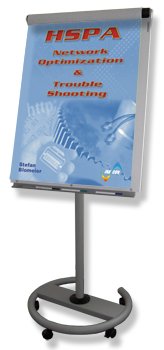 HSPA - Network Optimization & Trouble Shooting
HSPA - Network Optimization & Trouble Shooting
 Training Course Description
Training Course Description

- This course is targeted at engineers and technicians who are involved in the operation, optimization and troubleshooting of UMTS Rel. 5 and 6 high speed networks.
- This fascinating blend of practical experience and theoretical knowledge is a must for everybody who shall tune a HSDPA and HSUPA network.
- Part 1 of the course starts with practical issues of nowadays HSDPA networks followed by hands-on exercises of important throughput calculations, then continues with the analysis of parameter settings found in drive-test logfiles and Iub protocol traces and finally shows you how to debug HARQ logfiles.
- The second part of the course starts with an in-depth refresher on HSUPA topics like new physical channels, HARQ and E-TFCI Selection, continues with the update of SG in UE and lets the student determine possible max throughput rates, followed by parameter analysis found in drive-test and Iub protocol traces.
- Both high speed parts focus on mobility issues like cell change procedure and SRNS relocation issues affecting the throughput.
- The course explains the KPI’s and what problems can particularly throttle down the throughput in uplink and downlink and how to overcome these problems.
Some of your questions that will be answered
- Why there is still a Rel. 99 DCH, so called A-DCH needed for HS-DSCH operation?
- What HS-DSCH and E-DCH related parameters can be configured and reconfigured through e.g. Radio Bearer Setup, Radio Bearer Release, Radio Bearer Reconfiguration, Transport Channel Reconfiguration, Physical Channel Reconfiguration etc.?
- How can E-DCH and HS-DSCH coexist with Rel. 99 traffic on the same carrier without deteriorating RAB Success Rate / worsen Drop Rate?
- How can the F-DPCH enable the NodeB to serve more than 3 users simultaneously out of a pool of 15 HS-PDSCH’s?
- Why does the HS-DSCH downlink throughput decrease in SHO and what are the possible countermeasures?
- What influences the CQI reporting in UE and how can the UTRAN deal with inaccurate CQI’s in the long run?
- How can I identify faults in HS-DSCH Frame Protocol and RLC-AM throttling down the throughput?
- Why are frequent cell changes harmful for HS-DSCH performance and less for E-DCH?
- How to optimize the RLC-AM parameters (e.g. MaxDAT, timerPoll, transmissionWindowSize, pollPDU, inSequenceDelivery, timerStatusProbhibit etc.) of bearers mapped on HS-DSCH and E-DCH?
- Why is suddenly a RLC PDU size of 656 bits necessary for HSDPA Cat 8?
- What is the purpose of MAC-hs, Window Size and Reorder Release Timer T1 and how can they be optimized for different QoS requirements?
- What are the effective throughput rates at application layer for HS-DSCH and E-DCH considering UTRAN and TCP/IP (or RTP/UDP/IP) protocol overhead?
- How to tune power control parameters to reduce missed TTI’s and ACK/NACK misdetections in UE and NodeB for HS-DSCH and E-DCH operation?
- How can I interpret the parameters of HS-SCCH (e.g. code group indicator, code offset indicator, NDI X(RV) etc.) and debug HARQ logfiles?
 Who should attend this class?
Who should attend this class?
- Network operator staff who are involved in the optimization of HSDPA and EUL and who need to continuously improve the network performance.
- System vendors who are involved in second and third level troubleshooting activities of HSPA.
 Pre-Requisites
Pre-Requisites
- Participants need to be already familiar with UMTS and HSPA in particular. Experience in UMTS Rel. 99 optimization is advantageous.
- Customer should have collected Drive-test logs (e.g. TEMS, ROMES, XCA/XCAP, Agilent etc.) as well Iub- & Iu-ps Protocol Traces containing User Plane. The logs from the network are analyzed and used for immediate troubleshooting of flow control problems, HARQ retransmissions during cell change, throttled throughput, etc.
 Training Course Target
Training Course Target
- The student understands the critical parameters of uplink and downlink high speed and learns how to optimize them in order to reach best throughput performance.
- The participant is able to counteract the negative impact of HSDPA and HSUPA on Rel. 99 bearers coexisting on the same carrier.
- Moreover the student is enabled to evaluate drive-test logs and Iub protocol traces so he/she can identify UE or NodeB or RNC related faults. The participant can then improve the KPI's based on parameter tunings and verify the improved performance.
 Training Course Duration
Training Course Duration
- 4 days
v1.200
Search:
Advanced SearchMore Info:
Detailed ToC of this training course
Schedule of this training course
INACON eBooks
Please have a look at our full offer

